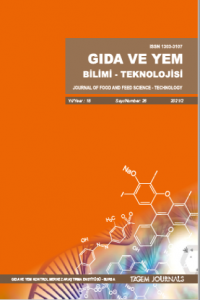Yumuşak Şekerlemelerde Kullanılan Yenilebilir Jelatin Orijininin LC Q-TOF İle Belirlenmesi
yumuşak şeker, domuz jelatini, sığır jelatini, aminoasit sekansı
___
- 4.Kaynaklar Boran, G.,Mulvaney, S.J. and Regenstein, J.M., 2010. Rheological Properties of Gelatin from Silver Carp Skin Compared to Commercially Available Gelatins from Different Sources. J FoodSci, 75 (8): 565- 571.
- Doi, H.,Watanabe, E. Shibata, H. AndTanabe, S., 2009. Areliable enzyme linked immunosorbent assay for the determination of bovine and porcine gelatin in processed foods. Journal of Agricultural and Food Chemistry, 57: 1721–1726.
- Draget, K.I., 2009. Handbook of hydrocolloids (Second edition) Editedby G O Phillipsand P AWilliams, GlyndwrUniversity, UK. Woodhead Publishing Series in Food Science, Technology and Nutritionpp 173-948 .
- Gross , J.H., 2004. Mass Spectrometry Atext book. 2nd ed. Germany: Springer 518s
- Grundy, H.H.,Reece, P. Buckley, M. Solazzo, C.M. Dowle , A.A. Ashford, D. Charlton, A.J. Wadsley, M.K. and Collins, M.J.,2016. A mass spectrometry method for the determination of the species of origin of gelatine in foods and pharmaceutical products. Food Chemistry, 190:276-284.
- Gui-Feng, Z., Tao, L. Qian, W. Jian-Du, L. Guang-Hui, M. andZhi-Guo, S., (2008). Identification of marker peptides in digested gelatins by high performance liquid chromatography/massspectrometry. Chinese Journal of Analytical Chemistry, 36: 1499–1504.
- Hermanto, S. and Fatimah, W. 2013. Differentiation of bovine and porcine gelatin based on spectroscopic and electrophoretic analysis. Journal of Food and Pharmaceutical Sciences, 1: 3.
- Hidaka, S. and Liu, S., 2003. Effects of gelatin on calcium phosphate precipitation: A possible application for distinguishing bovine bone gelatin from porcine skin gelatin. Journal of Food Composition and Analysis, 16: 477–483.
- Karim, A. A.,and Bhat, R., 2009. Fishgelatin: properties, challenges, and prospects as alternative to mammalian gelatins. Food Hydrocolloids, 23: 563–576.
- Kauschke, S.G.,Knorr, A. and Heke, M., 1999. Two assays forme asuring fibrosis: reverse transcriptasepolymerase chain reaction of collagen alpha (1) (III) mRNA is an early predictor of subsequent collagen deposition while a novel serum Nterminal procollagen (III) propeptide assay reflects manifest fibrosis in carbon tetrachloride-treated rats, Anal. Biochem, 275 : 131–140.
- Nhari, R., Ismail, A. and Che Man, Y., 2012. Analytical methods for gelatin differentiation from bovine and porcine origins and food products. Journal of Food S cience, 77: 42–46.
- Nimptsch, A., Schibur, S. Ihling, C. Sinz, A. Rieme, T. Huster, D. And Schiller, J. 2011. Quantitative analysis of denatured collagen by collagenase digestion and subsequent MALDI-TOF massspectrometry. Cell TissueRes, 343: 605–617.
- Sawhney, RS., 2005. Immunological identification of types I and III collagen in bovine lens epithelium and it's anterior lens capsule. Cell Biol. Int, 29: 133–137.
- Schrieber, R. and Gareis, H. 2007. Gelatine handbook. The ory and industrial practice. Weinheim: Wiley-VCH Verlag GmbH&Co. KGaA. Chapter 2 & 3.)
- Widyaninggar, A., 2012.Differentiation between porcine and bovine gelatin in capsule shells based on amino acıd profiles and principal component analysis J. Pharm. Vol. 23 No. 2:104 – 109 ISSN pp. 0126-1037
- Yetim, H. 2011. Jelatin üretimi, özellikleri ve kullanımı. 1. Ulusal Helal ve Sağlıklı Gıda Kongresi, 19-20 Kasım 2011, s. 86-94, Ankara.
- Yilmaz, M.T., Kesmen, Z. Baykal, B. Sagdic, O. Kulen, O. And Kacar, O., 2013. Anovel method to differentiate bovine and porcine gelatins in food products: NanoUPLC-ESI-Q-TOF-MSE based data independent acquisition technique to detect marker peptides in gelatin. Food Chemistry, 141: 2450–2458.
- ISSN: 1303-3107
- Yayın Aralığı: Yılda 2 Sayı
- Başlangıç: 2015
- Yayıncı: Bursa Gıda ve Yem Kontrol Merkez Araştırma Enstitüsü
Pseudomonas aeruginosa: Özellikleri ve Quorum Sensing Mekanizması
Gamların prebiyotik özellikleri
Mervenur KANDİL, Lütfiye YILMAZ ERSAN, Tülay ÖZCAN, Arzu AKPINAR-BAYİZİT
Yumuşak Şekerlemelerde Kullanılan Yenilebilir Jelatin Orijininin LC Q-TOF İle Belirlenmesi
Harun DIRAMAN, Ayşegül TÜRK BAYDIR
Bursa İli Mustafakemalpaşa Peynir Tatlısı Üreten İşletmelerin Sosyo-Ekonomik Yapısı
